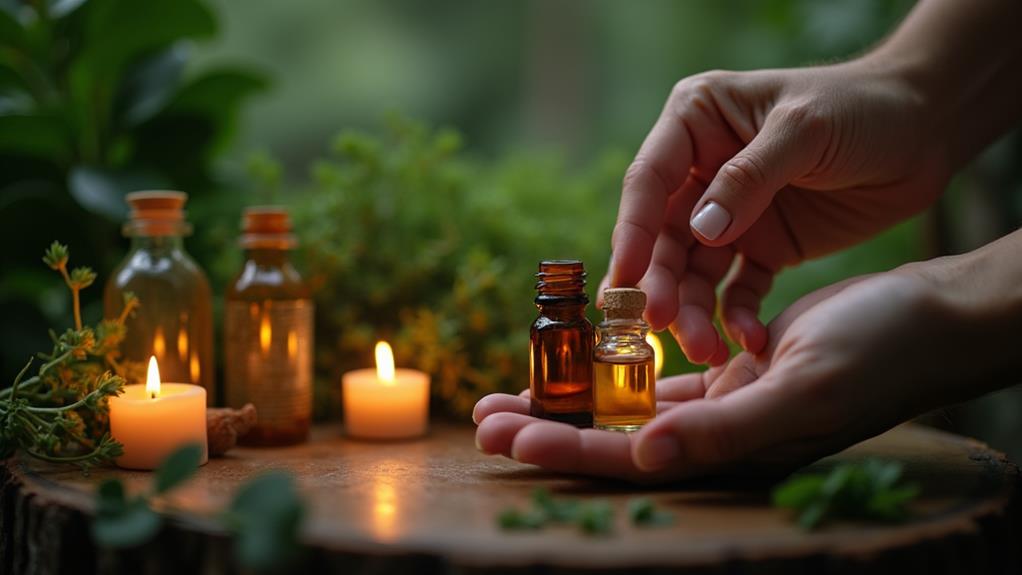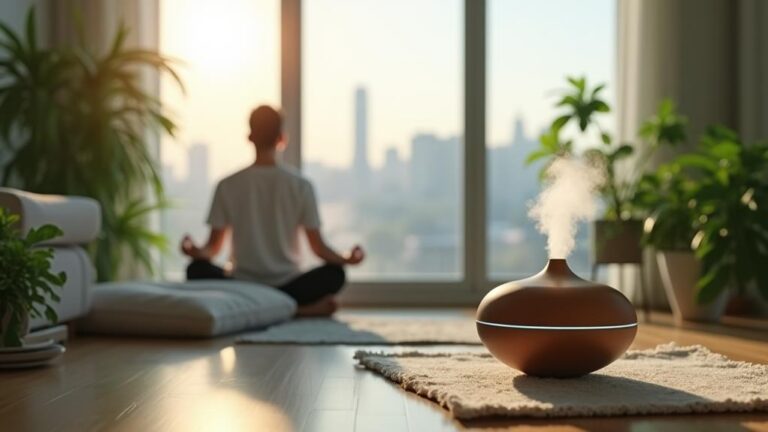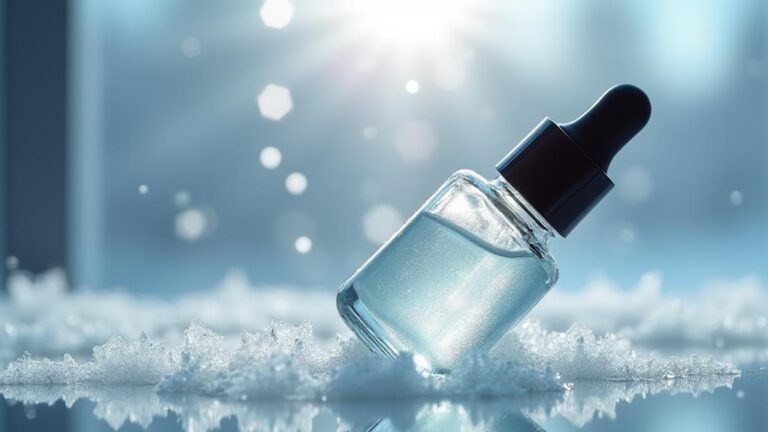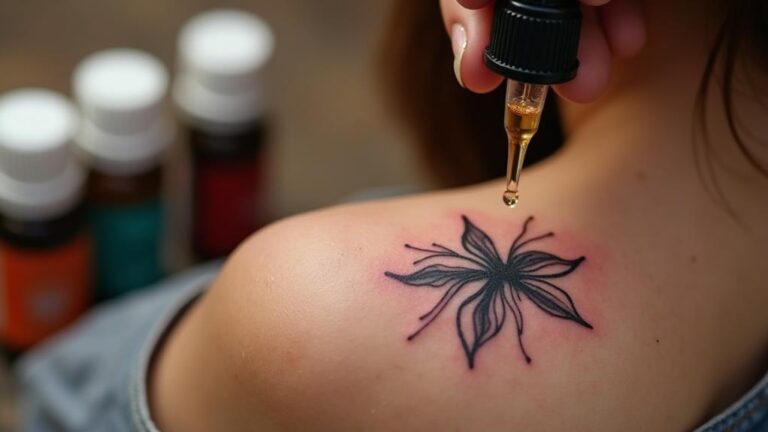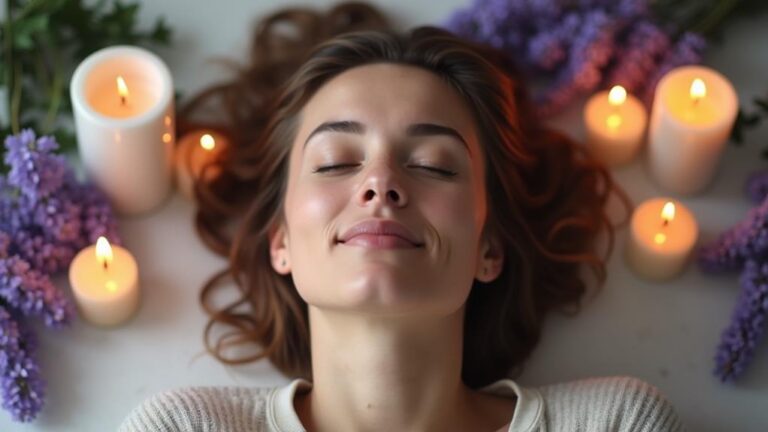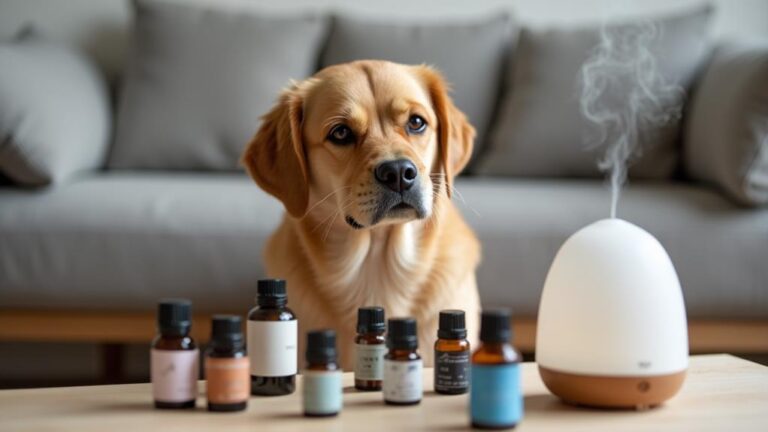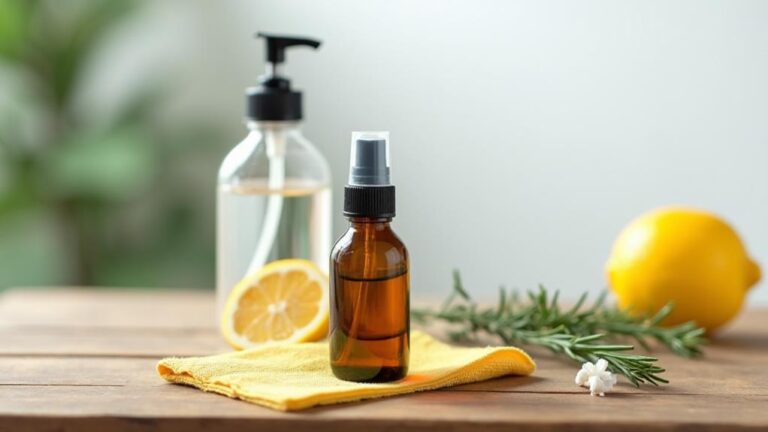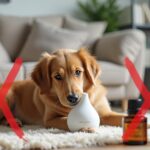When you're considering using essential oils on your body, it's vital to prioritize your safety and well-being. You're probably aware that essential oils are highly concentrated and can cause skin irritation or allergic reactions if not used properly. To minimize these risks, you need to understand the safe application methods and guidelines for using essential oils on your skin. From choosing the right carrier oil to performing a patch test, there are several key steps to take before applying essential oils. But what's the first vital step to take, and how do you guarantee you're using them correctly?
Key Takeaways
- Always perform a patch test on a discreet area of skin before applying a new essential oil to check for adverse reactions.
- Dilute essential oils properly according to recommended ratios, typically 1-3% essential oil concentration, to avoid skin irritation.
- Choose safe areas for essential oil application, such as the soles of the feet, palms of the hands, and behind the ears.
- Avoid applying essential oils to sensitive skin areas, including eyelids, under-eye areas, and mucous membranes.
- Follow proper skin preparation, such as gentle exfoliation and consistent cleansing routines, to promote better essential oil absorption.
Understanding Essential Oil Concentration
When it comes to using essential oils, understanding their concentration is key to applying them safely.
You need to know that essential oils are highly concentrated plant extracts with varying levels of essential potency. This potency can profoundly impact their effectiveness and safety when applied to the skin.
Essential oils can have between 1-30% of the active compounds that provide their therapeutic benefits.
However, oil variability is substantial, even within the same type of oil. For instance, lavender oil can have between 1-5% linalool, a compound responsible for its calming effects.
This variability can be attributed to factors like plant species, growing conditions, and extraction methods.
To apply essential oils safely, consider their concentration and potential interactions with your skin.
Always check the label for the recommended dilution ratio, and start with a small patch test to assess your skin's sensitivity.
Be aware that some oils, like peppermint and cinnamon, are highly concentrated and may require more dilution than others.
Understanding essential oil concentration and variability is vital to harnessing their therapeutic benefits while minimizing potential risks.
Choosing Safe Essential Oils
| Essential Oil | Potential Risks | Recommended Use |
|---|---|---|
| Tea Tree | Skin irritation if undiluted | Acne treatment, minor cuts |
| Lavender | None known | Relaxation, skin calming |
| Bergamot | Phototoxicity | Uplifting, stress relief (use in low light) |
| Eucalyptus | Respiratory issues if inhaled | Muscle relief, decongestant |
When evaluating brand quality, look for essential oils that are extracted using high-quality methods, such as steam distillation or cold pressing. Check the label for certifications like GC/MS testing, which verifies the oil's purity and potency. Additionally, opt for brands that provide clear instructions for use and recommended dilution ratios. By choosing safe essential oils and considering their properties, you can guarantee a positive and effective experience.
Essential Oil Dilution Methods
To safely use essential oils, you'll need to dilute them in a carrier oil before applying them to your skin, as undiluted essential oils can be irritating or even cause adverse reactions.
The general rule of thumb is to follow oil ratios that typically range from 1-3% essential oil concentration. For example, you can use 5-15 drops of essential oil per tablespoon of carrier oil. However, this ratio may vary depending on the specific essential oil, your skin type, and the desired outcome.
Blending techniques are also vital in diluting essential oils. You can use a single essential oil or combine multiple oils to create a synergistic blend.
When blending, it's vital to weigh the properties and potency of each oil to guarantee a safe and effective dilution. Always start with a low concentration and gradually increase as needed. It's also important to note that some essential oils, such as peppermint and eucalyptus, are more potent than others and may require lower dilution ratios.
Preparing the Skin for Oils
Before applying essential oils to your skin, it's vital that you prepare it properly to minimize potential irritation and allergic reactions.
You start by establishing a consistent skin cleansing routine that removes dirt, bacteria, and other impurities, allowing the skin to breathe and absorb the oils more effectively.
Additionally, consider performing patch tests to identify any skin allergies or sensitivities, which will help you choose the right oils and dilution ratios for your skin type.
Skin Cleansing Routine
As you prepare to incorporate essential oils into your skincare routine, it's crucial that your skin is clean and free of impurities.
A well-established skin cleansing routine sets the stage for effective essential oil application. For ideal results, it's recommended that you establish both a daily and nighttime skincare routine.
In terms of daily exfoliation, gently exfoliating your skin 1-2 times a week can help remove dead skin cells and promote better absorption of essential oils.
Use a gentle exfoliating scrub or a chemical exfoliant containing alpha-hydroxy acids (AHAs) or beta-hydroxy acids (BHAs). Be sure to rinse your skin thoroughly after exfoliating.
At night, follow a consistent nighttime routine that includes cleansing your skin with a gentle cleanser, toning to balance your skin's pH, and moisturizing to lock in hydration.
This routine helps prepare your skin for the next day and creates a clean canvas for essential oil application. By incorporating these simple steps into your skincare routine, you'll be well on your way to creating an environment that allows essential oils to work effectively and safely on your skin.
Patches and Allergies
Your skin is now clean and prepared for the next step in using essential oils safely.
Before applying essential oils directly on your skin, it's vital to check for any potential skin reactions or allergies.
A patch test is the best way to do this. Choose a small area of skin, such as behind your ear or on your wrist, and apply a few drops of the essential oil you want to use.
Dilute the essential oil with a carrier oil if recommended, and gently rub it into the skin. Wait 24-48 hours to see if any skin reactions occur.
If you experience redness, itching, or swelling, remove the oil immediately and wash the area with soap and water. This indicates that you're allergic to the oil and should avoid using it.
If you don't experience any skin reactions, you can proceed with using the essential oil safely.
Remember to perform a patch test for each new essential oil you want to use, even if you've used similar oils before.
This confirms that you're not introducing a new allergen to your skin and minimizes the risk of adverse reactions.
Essential Oil Application Methods
When using essential oils, it's crucial to choose the right application method to maximize their effectiveness and minimize potential risks.
You can use essential oils in various ways, depending on your health goals and preferences.
Essential massage is a popular method, where you dilute a few drops of essential oil with a carrier oil and massage it into your skin.
This technique helps relieve muscle tension, improves circulation, and promotes relaxation.
Another effective method is using aromatic baths.
You can add a few drops of essential oil to your bath water, which helps to unwind and rejuvenate your body and mind.
The warm water opens up your pores, allowing the essential oil to penetrate deeper into your skin.
You can also inhale the vapors, which helps to clear your respiratory system and calm your mind.
Regardless of the method you choose, always dilute essential oils with a carrier oil, and perform a patch test to safeguard you're not allergic to the oil.
Safe Areas for Essential Oils
Applying essential oils to the correct areas of the body is just as important as choosing the right application method.
When using essential oils, you'll want to focus on specific body zones that allow for peak absorption and effectiveness. Oil mapping, also known as zone therapy, is a technique that divides the body into distinct zones, each associated with specific organs and systems.
By targeting these zones, you can enhance the benefits of your essential oils.
You can apply essential oils to the soles of your feet, as this area is rich in nerve endings that connect to various organs and systems.
Other safe areas for essential oil application include the palms of your hands, behind your ears, and along your spine.
You can also use essential oils on your pulse points, such as your wrists, temples, and neck.
When applying essential oils to these areas, be sure to dilute them properly and test for sensitivity.
By targeting the right body zones, you can maximize the benefits of your essential oils and promote overall well-being.
Always consult with a healthcare professional or certified aromatherapist before using essential oils, especially if you're new to aromatherapy.
Avoiding Sensitive Skin Areas
| Sensitive Skin Areas | Skin Types to Avoid | Recommended Alternatives |
|---|---|---|
| Eyelids and under-eye | All skin types | Use gentle, fragrance-free products instead |
| Mucous membranes | Sensitive skin | Avoid applying essential oils to areas like the nose, mouth, and genital area |
| Facial areas (e.g., mouth, lips) | Dry or chapped skin | Choose gentle, nourishing products for these areas |
| Broken or irritated skin | All skin types | Wait until skin has healed before applying essential oils |
| Genital area | Sensitive skin | Use gentle, fragrance-free products instead and avoid essential oils |
You should also be cautious when applying essential oils to facial areas, especially if you have sensitive skin. Certain essential oils can cause skin irritation, redness, or dryness. Always dilute essential oils and perform a patch test before applying them to sensitive areas.
Essential Oil Allergy Testing
Your skin is as unique as you, so it's essential to test essential oils for potential allergic reactions.
Oil reactions can range from mild irritation to severe skin sensitivities.
To safeguard your safety, it's pivotal to perform a patch test before using a new essential oil.
When testing for oil reactions, start by applying a small amount of the diluted essential oil to a discreet area of your skin, such as behind your ear or on your wrist.
Wait 24-48 hours to observe any adverse reactions.
If you experience any irritation, redness, or itching, discontinue use of the oil.
- Dilute the essential oil: Mix a few drops of the essential oil with a carrier oil, such as coconut or jojoba oil, to reduce the risk of skin irritation.
- Apply to a small area: Choose a discreet area of your skin to apply the diluted essential oil.
- Monitor for reactions: Wait 24-48 hours to observe any adverse reactions, such as redness, itching, or irritation.
Using Essential Oils With Children
When using essential oils with children, you need to take extra precautions to safeguard their safety.
It's vital to dilute essential oils properly for children, as their skin is more sensitive, and to ponder age-specific precautions to avoid potential health risks.
Dilution for Children
Using essential oils with children requires careful consideration due to their sensitive skin and developing immune systems.
When it comes to pediatric aromatherapy, dilution is vital to guarantee safe and effective use.
To create kid-friendly blends, you'll need to dilute essential oils in a carrier oil. The general rule of thumb for dilution in pediatric aromatherapy is to use a lower concentration of essential oils compared to adult applications.
- Infants (0-12 months): 0.5-1% essential oil concentration (5-10 drops per 2 tablespoons of carrier oil)
- Toddlers (1-3 years): 1-2% essential oil concentration (10-20 drops per 2 tablespoons of carrier oil)
- Children (4-12 years): 2-3% essential oil concentration (20-30 drops per 2 tablespoons of carrier oil)
When diluting essential oils for children, always use a gentle carrier oil like coconut or jojoba oil.
Start with a small patch test to guarantee your child doesn't have any adverse reactions.
Age-Specific Precautions
Age-specific precautions are vital when incorporating essential oils into a child's daily routine.
As you ponder using essential oils with children, remember that their skin is more sensitive than adults. Toddler sensitivities, in particular, require extra caution. Always dilute essential oils with a carrier oil, and use gentle, child-friendly oils like lavender or chamomile.
When using essential oils with children, it's also important to ponder their age and developmental stage.
Infants under six months shouldn't be exposed to essential oils, while older children may be able to tolerate them in small amounts. If you're using essential oils with children, always supervise them closely and watch for signs of irritation or allergic reactions.
While elderly precautions are also important, they aren't directly related to using essential oils with children.
However, note that older adults may be more sensitive to essential oils due to decreased skin thickness and metabolism. If you're using essential oils with children, be sure to store them safely out of reach to avoid accidents.
Safe Application Methods
Applying Essential Oils Safely
Safe Application Methods
As a parent or caregiver, applying essential oils to children requires careful deliberation and attention to safe methods.
You'll want to verify that the essential oils you use are gentle on their skin and won't cause any adverse reactions.
When using essential oils with children, it's vital to ponder their skin preparation and oil absorption rates.
Children's skin is thinner and more delicate than adult skin, making it more susceptible to irritation.
To minimize the risk of skin irritation, you can:
- Dilute essential oils: Always dilute essential oils in a carrier oil before applying them to a child's skin to reduce the risk of irritation.
- Choose gentle essential oils: Opt for gentle essential oils that are known for their calming and soothing properties, such as lavender or chamomile.
- Start with small amounts: Begin with small amounts and gradually increase as needed and tolerated.
Essential Oil Storage and Handling
Proper essential oil storage and handling are crucial to maintaining their quality, safety, and effectiveness.
When it comes to storing essential oils, you'll want to follow some key storage tips to preserve oil quality.
First, store essential oils in a cool, dark place, such as a cupboard or drawer.
Avoid placing them near heat sources, like radiators or ovens, as heat can cause the oils to degrade.
You should also keep essential oils away from direct sunlight, as UV rays can break down the oil's molecular structure.
Use dark glass bottles to store essential oils, as these can block out UV rays and prevent degradation.
Keep the bottles tightly sealed when not in use to prevent oxidation and contamination.
It's also a good idea to label each bottle with the oil's name, the date you opened it, and any safety precautions you should take when using it.
By following these storage tips, you can help maintain the quality and effectiveness of your essential oils.
Proper storage and handling will also reduce the risk of accidents and safeguard safe use.
Frequently Asked Questions
Can Essential Oils Be Used on Broken or Open Skin?
When dealing with broken or open skin, you should exercise caution. Essential oils can exacerbate skin sensitivity and potentially hinder wound healing. Always dilute oils in a carrier oil and perform a patch test before applying.
Are Essential Oils Safe for Use During Pregnancy?
You're enthusiastically planning a nursery, envisioning a tiny tot's first steps, yet wondering if your self-care routine is safe. Essential oils pose pregnancy risks, potentially hindering fetal development, so use them cautiously or avoid them altogether.
Can I Use Essential Oils on My Pets?
You're considering essential oils for your pets, but it's vital to exercise caution due to potential pet anxiety and fur sensitivity. Always consult a veterinarian before use, as some oils can be toxic or irritating.
How Long Do Essential Oils Stay on the Skin?
You'll be wearing essential oils for a thousand years, or so it might seem. In reality, skin absorption occurs within 20-30 minutes, leaving a minimal oil residue that usually fades after 2-3 hours.
Can I Ingest Essential Oils for Internal Benefits?
Ingesting essential oils for internal benefits requires caution. You must guarantee high oil quality and research internal dosage guidelines, as improper use can be hazardous. Always consult a healthcare professional before consuming essential oils.
Conclusion
As you master the art of applying essential oils safely on the body, remember that one misstep can have lasting consequences. The delicate balance between healing and harm hangs in the balance with every application. Will you be the guardian of your own well-being, or will the allure of nature's potent remedies prove too great to wield wisely? The choice is yours, and the responsibility is now in your hands.


